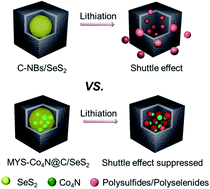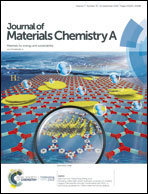Chelation-assisted formation of multi-yolk–shell Co4N@carbon nanoboxes for self-discharge-suppressed high-performance Li–SeS2 batteries†
Abstract
Selenium sulfides are considered attractive cathode materials for lithium storage due to their higher specific capacities than elemental selenium and better electrical conductivity than sulfur. However, due to the dissolution of intermediate polyselenides and polysulfides, selenium sulfides suffer from fast capacity degradation and low coulombic efficiency. Herein, we report a chelation competition induced polymerization (CCIP) strategy for the synthesis of multi-yolk–shell Co4N@carbon (MYS-Co4N@C) nanoboxes as an advanced SeS2 host material, which can simultaneously achieve good rate capability and cycling stability. Due to both physical confinement by carbon shells and strong chemical affinity of polar Co4N yolks, the MYS-Co4N@C nanoboxes can restrict the outward diffusion of Sx2− and Sex2− intermediates to suppress self-discharge and boost cycling stability. Benefitting from the high metallic conductivity and catalytic activity of Co4N, the SeS2-filled MYS-Co4N@C composite cathode also shows good electron/ion transport properties, and thus the redox kinetics and utilization ratio of the SeS2 active material can be improved. As a result, a high specific capacity retention and a superior rate capability can be achieved at a high SeS2 loading content of 70 wt%. When the mass loading of SeS2 is increased to 4.5 mg cm−2, the composite cathode still exhibits high reversible capacity and stable cycle performance.



 Please wait while we load your content...
Please wait while we load your content...